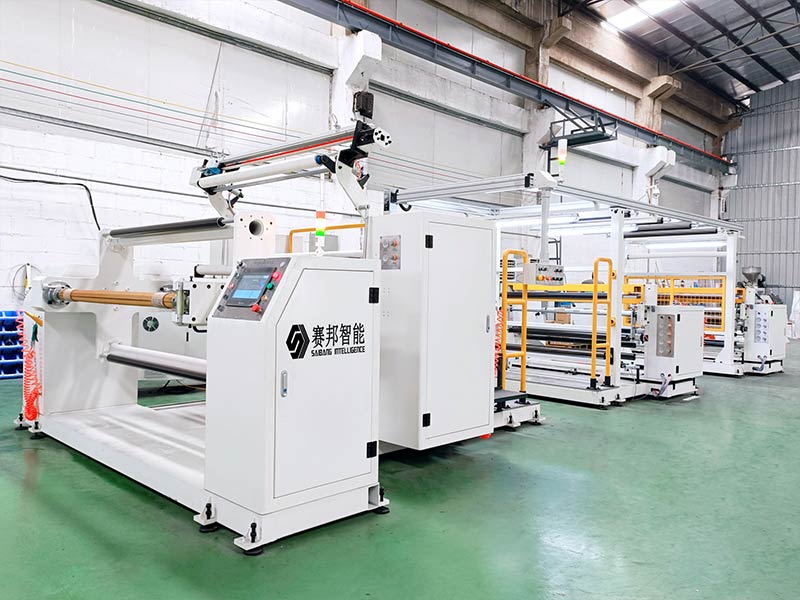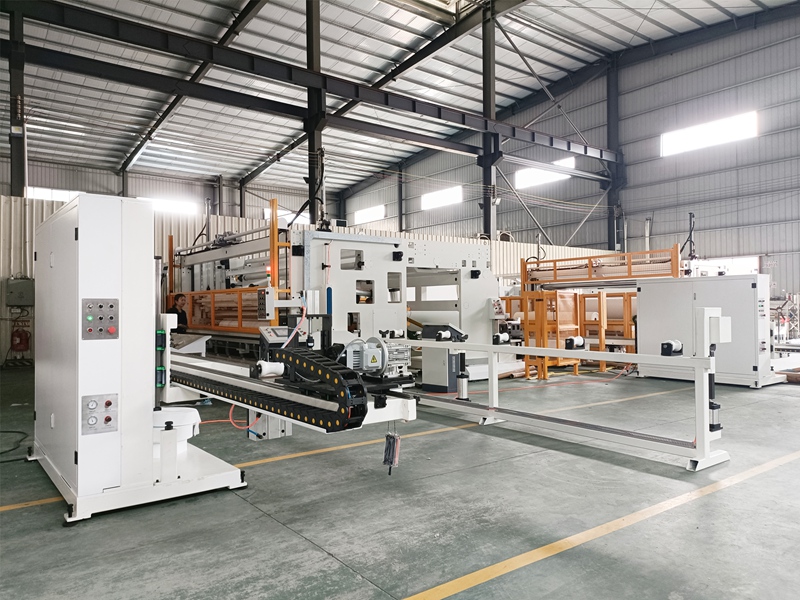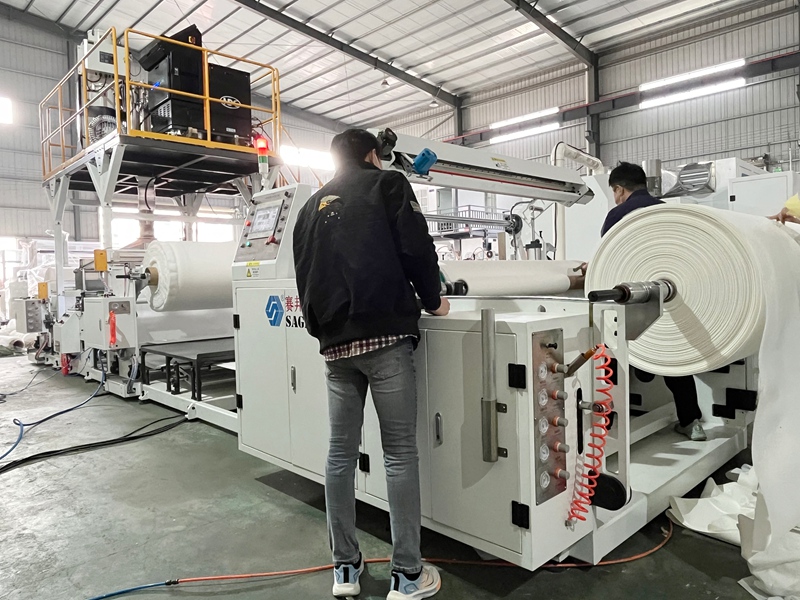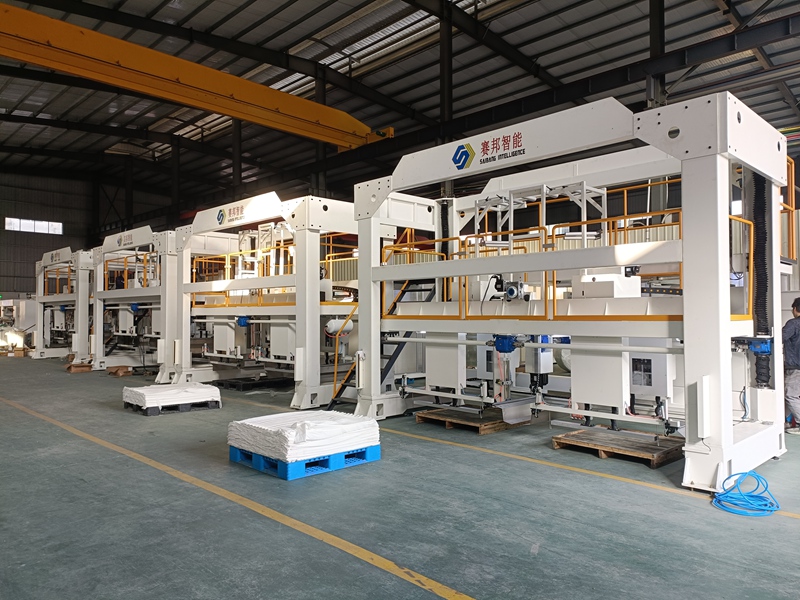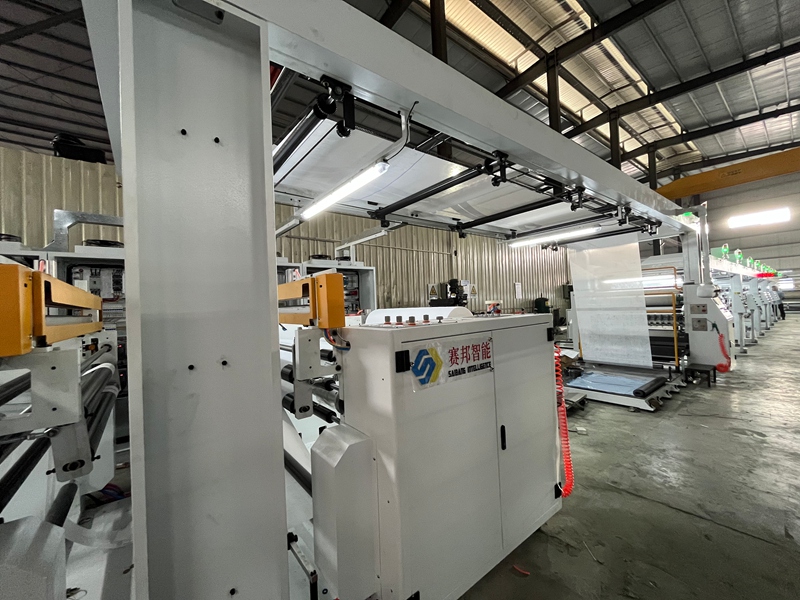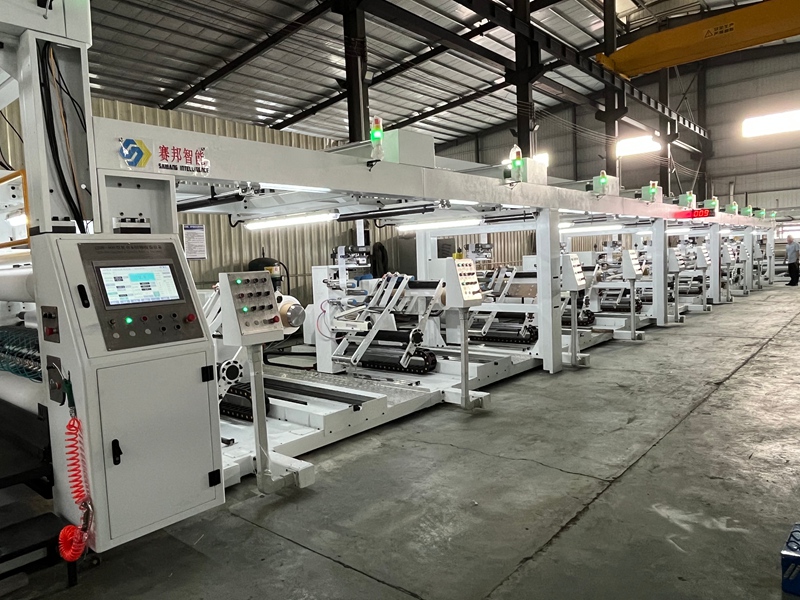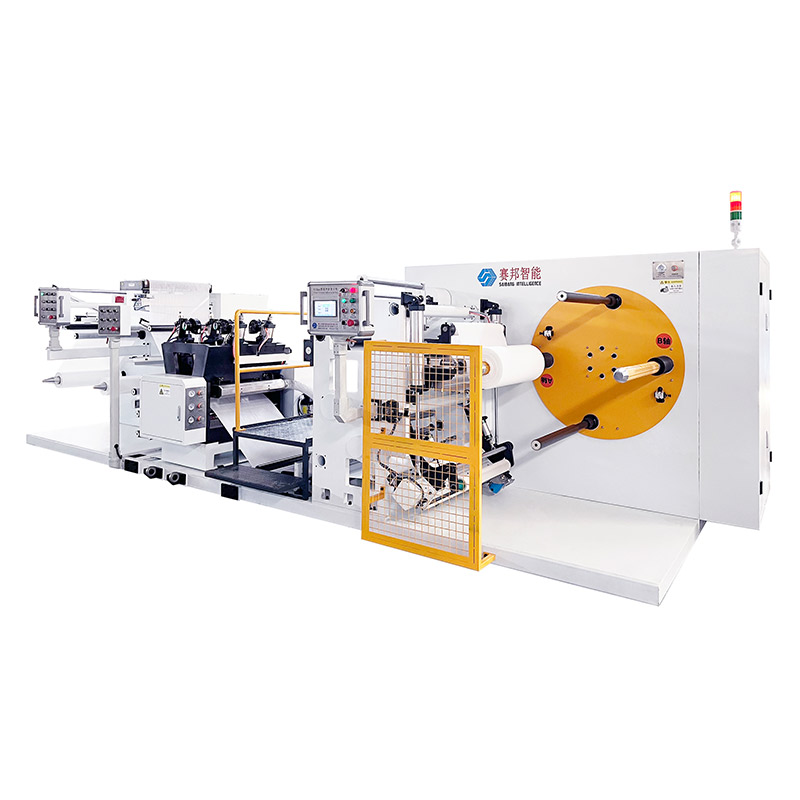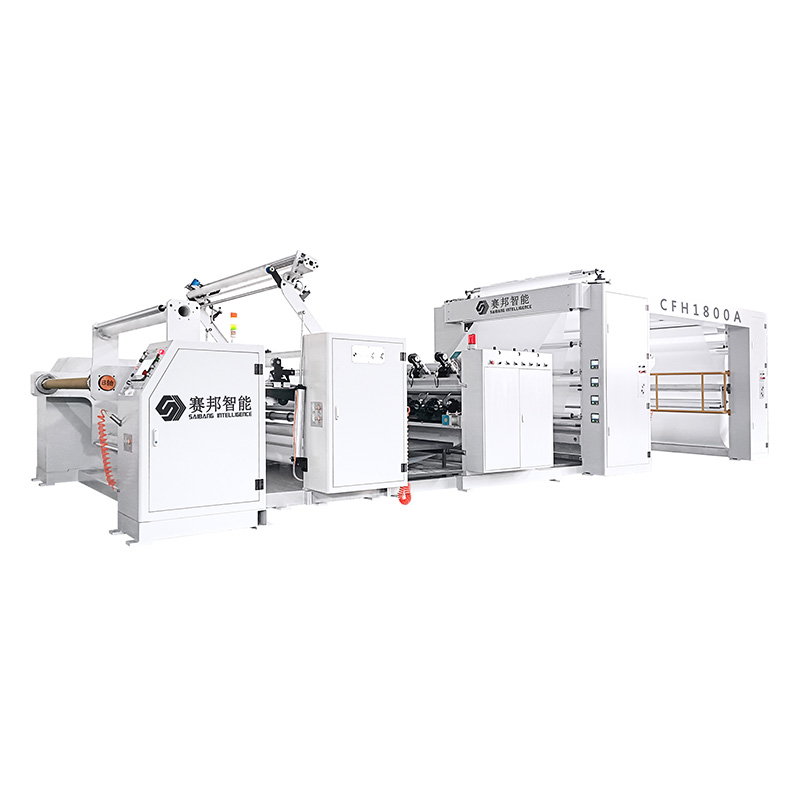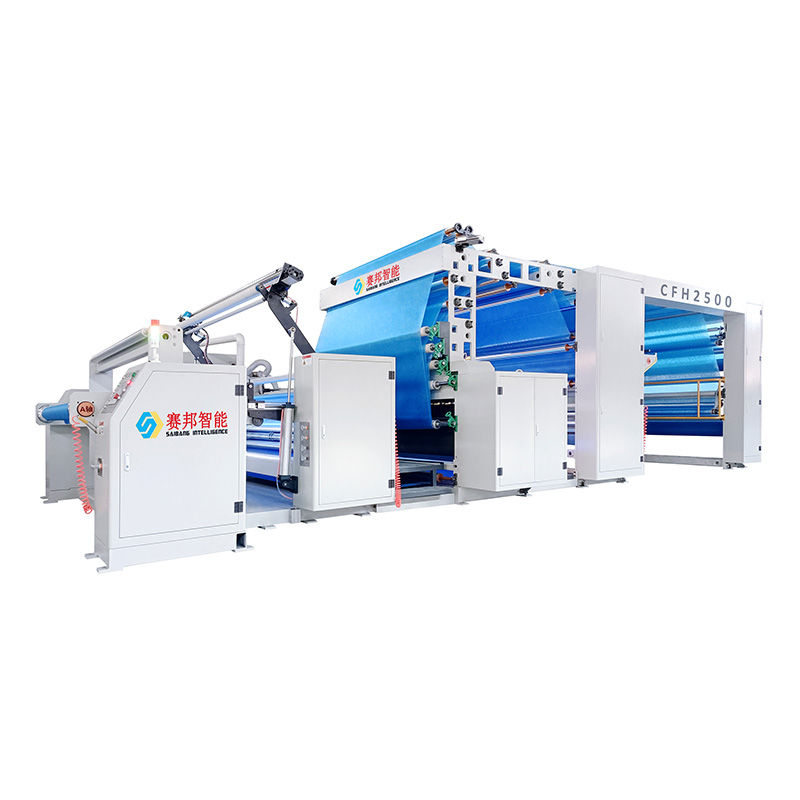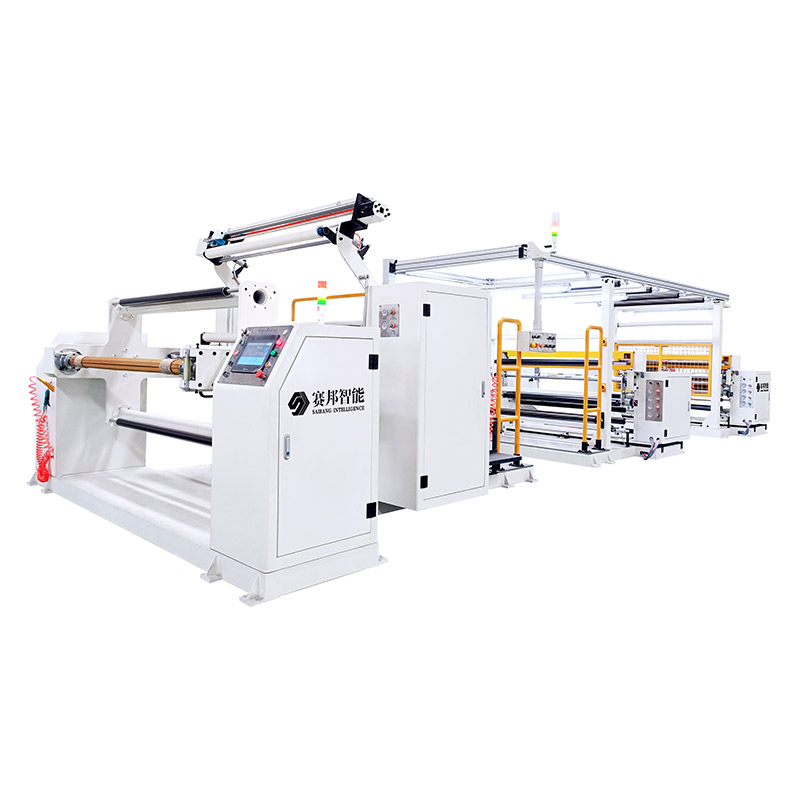
This Hot Press Laminating Machine is a mechanical device specially used to laminate different materials together through hot pressing process. It uses non-woven fabric as the main substrate, and can be matched with a variety of other materials, such as plastic film, paper, etc., using hot pressing technology to make these materials fuse with each other under the action of high temperature and pressure to form a composite material with specific properties and uses. The equipment usually consists of several key parts, including a substrate unwinding device, which is used to smoothly and continuously release the substrate to be laminated from the roll; a laminating device, which is the core part, which makes the materials tightly combined by heating and pressurizing; a host control system, which is responsible for accurately controlling the operating parameters of the equipment, such as temperature, pressure, speed, etc.; and a trimming and winding device, which trims the composite material to meet the specified size and winds the finished product into a roll.

1400mm Hot Press Laminating Machine for Nonwoven parameter
| Model: | SFH14A |
| Brand: | Saibang Intelligence |
| Adaptation Materials: | Nonwoven Fabric And Other Sanitary Materials |
| Machine Width: | 1400mm |
| Max Design Speed: | 100m/min |
| Normal Speed: | 90m/min |
| Effective Roller Surface Width: | 1200mm |
| Unwinding Diameter: | 1st: Φ1000mm; 2nd: Φ1000mm |
| Winding Diameter: | Φ1300mm |
| OEM: | OEM/ODM |
1400mm Hot Press Laminating Machine for Nonwoven features
High-speed production capacity: The maximum design speed of this machine can reach 100 meters/minute. In actual production, the normal speed is 90 meters/minute. This high-speed production capacity can greatly improve production efficiency, which can be increased several times or even more than traditional equipment. For example, when producing composite materials for the surface layer of surgical gowns, according to the normal speed of 90 meters/minute, 5400 meters of material can be produced per hour, which greatly shortens the production cycle and meets the needs of large-scale production.
Wide-width production: The machine width of the equipment is 1400mm, and the effective roller surface width is 1200mm. The wide-width design enables the equipment to process wider materials at one time, reducing the splicing process in the production process, and improving production efficiency and product quality consistency. Taking the production of composite materials for the surface layer of protective clothing as an example, wide-width production can ensure that the surface material of each protective clothing has uniform thickness and performance, improving the overall quality of the protective clothing.
Large roll diameter unwinding and rewinding: In terms of unwinding diameter, the first unwinding and second unwinding diameters are both Φ1000mm; the rewinding diameter is Φ1300mm. The large roll diameter design allows the equipment to accommodate more substrates and finished materials, reduces the frequency of roll changes, and improves production continuity. For example, when producing diaper surface composite materials, large roll diameter unwinding can ensure that the equipment does not need to change the substrate roll for a long time, reducing downtime and improving production efficiency.
Accurate control system: The host control system adopts advanced electronic control technology, which can accurately control the operating parameters of the equipment, such as temperature control accuracy up to ±1℃, pressure control accuracy up to ±0.01MPa, and speed control accuracy up to ±0.1m/min. This precise control capability ensures the quality stability and consistency of the composite material. When producing sanitary napkin surface composite materials, precise temperature and pressure control can ensure the bonding strength and softness between materials, and improve the comfort and quality of sanitary napkins.
Humanized operation interface: The operation interface adopts a humanized design, and the operator can easily set and adjust the operating parameters of the equipment, such as temperature, pressure, speed, etc., through the touch screen or buttons. At the same time, the interface also has real-time monitoring and alarm functions, which can display the operating status and fault information of the equipment in time, making it convenient for operators to perform maintenance and repairs. For example, when the temperature of the equipment is abnormal, the operation interface will immediately send out an alarm signal and display the fault location and cause. The operator can quickly troubleshoot the fault according to the prompts.
Support OEM/ODM: The equipment supports OEM (original equipment manufacturer) and ODM (original design manufacturer) services. Customers can customize the appearance, functions and performance of the equipment according to their needs to meet the personalized needs of different customers. For example, some customers may require equipment of special size or composite devices with specific functions. Equipment manufacturers can customize production according to customer requirements and provide customers with one-stop solutions.
Medical and health care industry:
Surgical gown production: The surface composite material used to produce surgical gowns. By compounding non-woven fabrics with other materials with waterproof, breathable, antibacterial and other properties, surgical gowns have good protective performance and comfort, which can meet the strict requirements during surgery.
Protective clothing production: In the production of protective clothing, the equipment can compound non-woven fabrics with materials such as plastic films to produce protective clothing with anti-virus and anti-chemical functions, providing effective protection for medical staff and special industry personnel.
Diaper and sanitary napkin production: The surface composite material used to produce diapers and sanitary napkins. By compounding materials with different properties, the product has the characteristics of softness, breathability, water absorption, etc., which improves the comfort and quality of the product.
Packaging industry:
Food packaging: Non-woven fabrics can be compounded with plastic films, paper and other materials to produce food packaging materials with moisture-proof, anti-oxidation, and fresh-keeping functions, extending the shelf life of food and ensuring the quality and safety of food.
Pharmaceutical packaging: used to produce pharmaceutical packaging materials. By compounding materials with different properties, the packaging has moisture-proof, light-proof, and pollution-proof functions to ensure the quality and stability of the drugs.
Household goods industry:
Curtain production: Non-woven fabrics can be compounded with decorative materials to produce curtains with beautiful, sound-proof, and heat-insulating functions to meet people's needs for home decoration and comfort.
Carpet production: used to produce the backing material of carpets. By compounding non-woven fabrics with other materials, the strength and stability of carpets are improved and the service life of carpets is extended.
Automotive interior industry:
Automotive seat fabric production: Non-woven fabrics can be compounded with leather, fabrics and other materials to produce automotive seat fabrics with soft, wear-resistant, and breathable functions to improve the comfort and beauty of automotive seats.
Automobile sound insulation material production: used to produce automotive sound insulation materials. By compounding materials with different properties, the sound insulation effect of the car is improved and the noise inside the car is reduced.
1400mm Hot Press Laminating Machine for Nonwoven maintenance
Daily cleaning:
Equipment surface cleaning: After the production is completed every day, use a clean soft cloth to wipe the surface of the equipment to remove dust, oil and other impurities to keep the appearance of the equipment clean and tidy. For some difficult-to-clean parts, such as gaps and corners, you can use a brush or vacuum cleaner to clean them.
Roller surface cleaning: Regularly clean the roller surface of the composite device to prevent material residue and impurity accumulation from affecting the composite quality. You can use a special detergent and soft cloth to wipe it to ensure that the roller surface is smooth and free of stains.
Lubrication maintenance:
Regular lubrication: According to the requirements of the equipment manual, regularly lubricate the various moving parts of the equipment, such as bearings, chains, gears, etc. Choose suitable lubricants or greases to ensure good lubrication and reduce wear and friction of parts.
Lubrication inspection: Before each production, check the lubrication of the equipment. If insufficient lubrication or deterioration of the lubricant is found, the lubricant should be added or replaced in time. At the same time, check the sealing of the lubrication system to prevent lubricant leakage.
Electrical system inspection:
Regular inspection: Regularly check the electrical system of the equipment, including wires, cables, switches, sensors, etc., to ensure that the electrical connection is good, without looseness, breakage, etc. Check the working status of electrical components, and replace them in time if any abnormality is found.
Moisture and dustproof: Keep the electrical system dry and clean to prevent moisture and dust from entering the electrical components and affecting their normal operation. Desiccant can be placed in the electrical control cabinet to clean dust regularly.
Mechanical component inspection:
Tightening inspection: Regularly check the mechanical components of the equipment, such as bolts, nuts, pins, etc., to ensure that they are reliably fastened and without looseness. If looseness is found, tighten them in time.
Wear inspection: Check the wear of mechanical components, such as bearings, gears, chains, etc. If severe wear is found, they should be replaced in time. At the same time, check the matching clearance of mechanical components to ensure that they meet the requirements.
Heating system maintenance:
Cleaning heating elements: Regularly clean the heating elements of the heating system, such as heating tubes, heating plates, etc., to remove dirt and impurities on the surface and improve heating efficiency. You can use a special detergent and soft cloth to wipe.
Check the temperature sensor: Check the working status of the temperature sensor to ensure that it measures accurately. If the temperature sensor is faulty, it should be replaced in time. At the same time, check the temperature control function of the heating system to ensure its normal operation.
Regular maintenance plan:
Develop a maintenance plan: According to the use of the equipment and the requirements of the manual, develop a detailed regular maintenance plan, including maintenance items, maintenance cycles, maintenance personnel, etc. Perform maintenance according to the plan to ensure the normal operation of the equipment.
Record maintenance: Keep a detailed record of each maintenance, including maintenance time, maintenance items, problems found and handling, etc. Recording can help you understand the operating status of the equipment and provide a reference for equipment maintenance and replacement.
Foshan Saibang Intelligent Equipmemt Co., Ltd. is located in nanhai District, an important industrial town in Guangdong Province, is a research and development, manufacturing, sales in one of the National High-tech Enterprise. The founding team of the company has been deeply engaged in the new material industry for 15 years, and is committed to the R&D, manufacturing and technical integration of special equipment for the new material & medical and eisai special equipment, providing systematic solutions and technical services for customers. We have over 30 independent intellectual property rights, and after years of experience accumulation, we currently has customers all over the country, Southeast Asia, Europe, and South America.Our products include casting/laminating equipment, coating machine, non-woven special equipment, all kinds of non-standard automation equipment and related mechanical and electrical accessories.
We adhere to the development philosophy of "technology leading, quality winning, service first, and win-win cooperation", with continuous research and development power for the industry to push technical equipment of cutting edge, with stable quality based on competitive global market, with sincere technology service realize the value of customer demand.



